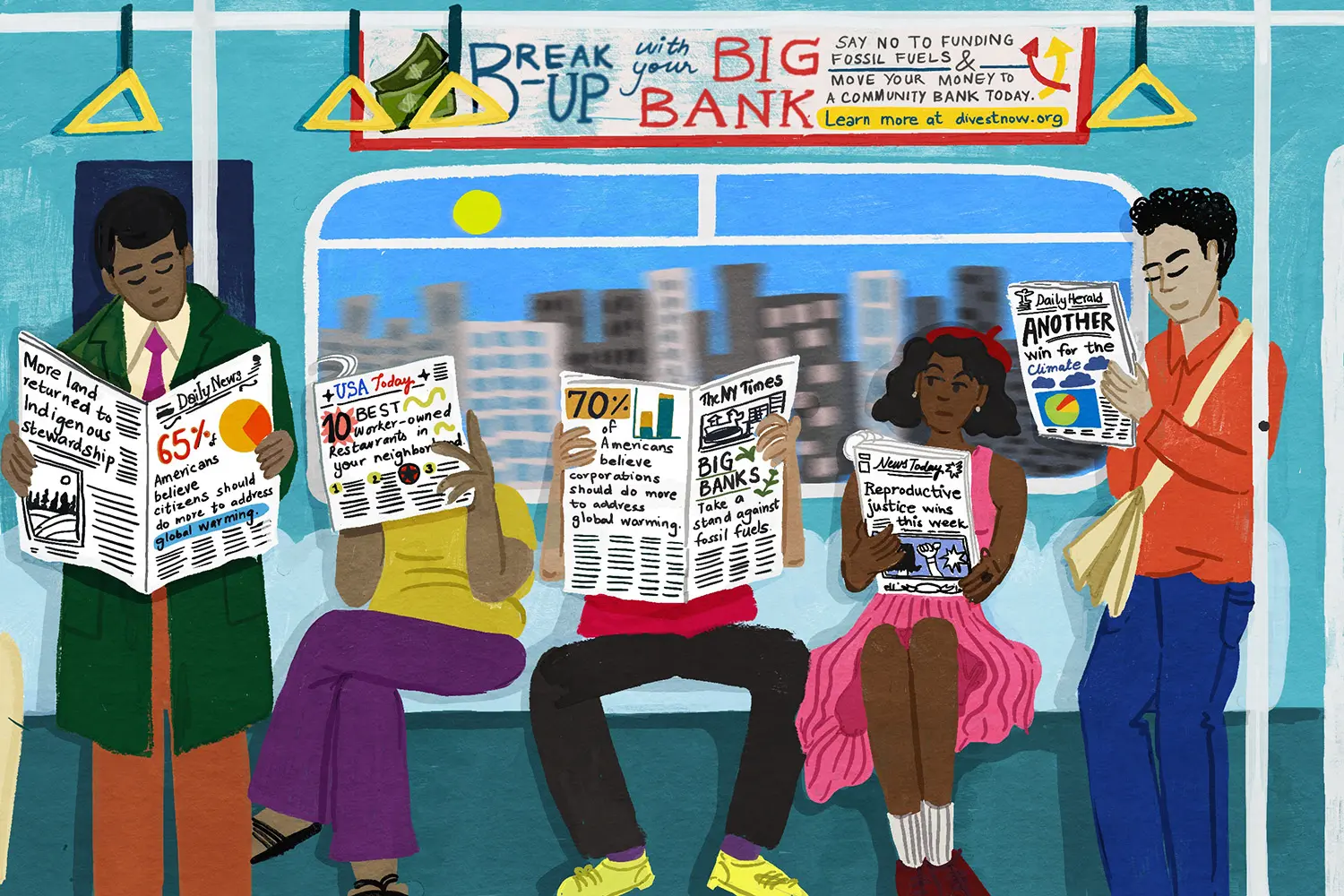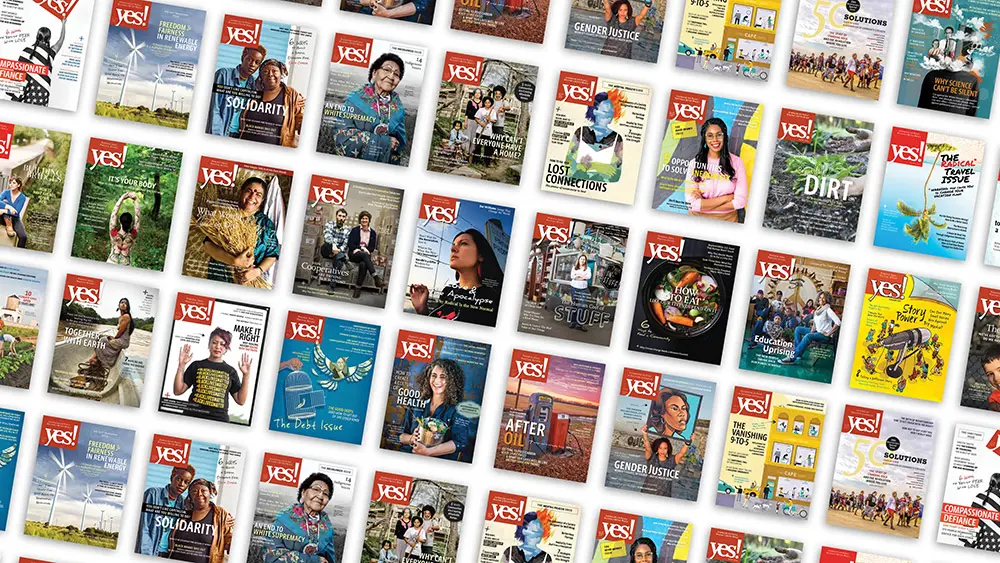Climate resilience as Story-Based Strategy

What it is: Story-based strategy is a specific framework and set of tools put forth by the Center for Story-based Strategy to help grassroots movements cultivate and prioritize radical imagination, strong narrative analysis, and thoughtful storytelling in their strategy. It was developed to help organizers and activists craft accessible, memorable, and evocative stories, as well as to better analyze narratives— unpack messaging, identify power dynamics at play, and understand audiences more deeply.
When we talk about story-based strategy in this context, we’re referring to a thoughtful, participatory, and justice-oriented approach towards shaping and delivering ancient, emerging, and new stories as well as deconstructing, challenging, and intervening within existing stories and larger narratives. We use story-based strategy as an umbrella term that includes other social justice strategies utilized to disrupt and create narrative power and tell better stories. That being said, there are important distinctions between strategies and terms (i.e. stories have a beginning, middle and end and include characters, conflict, and imagery, while narratives are the ideas and themes that appear across collections of stories and messages; stories told over and over again give rise to new narratives), and you can learn more about some of those here and here (thanks Narrative Initiative!).
The power of story is, in fact, something we underestimate at our peril. Rob Hopkins, Founder of the Transition Movement and Author (source)
Some additional context: It should be no surprise that the success of organizer and activist campaigns and movements often hinges upon their ability to tell really good stories that challenge dominant narratives and shape popular culture—after all, storytelling is an ancestral practice across all cultures that has been used to inform, educate, entertain, connect, and make meaning for millennia. Yet the importance of storytelling is often overlooked.
Why it’s a climate resilience powerhouse:
Creating climate narratives that are resonant, imaginative, and activating
The climate movement specifically has historically suffered from a lack of compelling storytelling. While there are undoubtedly numerous climate communicators working hard to deliver climate stories with nuance, creativity, and care, a lot of the messaging developed by environmentalists and reinforced by the media over the past several decades has fallen into the same handful of traps: it has framed the climate crisis as a faraway problem, both in time and space, it has fixated on abstract trends and quantitative data, and it has failed to connect climate change to social justice issues and everyday quality of life. The most-discussed solutions have been framed as too small, like minimizing one’s own carbon footprint, or too out of reach, like passing federal legislation or inventing groundbreaking technology. The tone of climate discourse has frequently oscillated between cold, fact-focused language, extreme panic and doomism, and technocentric optimism. Altogether, dominant narratives around climate change have largely failed to mobilize the masses into action. They have instead left many folks feeling overwhelmed, mired in guilt, unsure how to act, and afraid in the face of the future.
This moment calls for a new set of climate stories and amplification of the folks who are already doing climate storytelling differently. To successfully navigate our way through and beyond the climate crisis, we will need to prioritize radical imagination and collectively envision different ways of being in the world and relating to one another and the more-than-human world. Thoughtful storytelling is the first step in helping people to expand perceptions of what’s possible and actualize just futures.
Continue readingPeople will not go someplace we have not first traveled to in our minds… We must first craft together and paint for others an irresistible vision of the future. Christine Cordero, APEN co-director and former program director at the Center for Story-based Strategy (source)
Preserving memories and collectively healing
Storytelling is not just about looking into the future- it’s also about remembering and uplifting the past. Stories have always been essential to preserving and passing down cultural traditions, teachings, values, along with memories of people, places and moments. Reclaiming ancestral stories can be deeply healing, especially for peoples who have experienced systemic erasure of their culture(s). Stories of/from the past can also invite connection across generations and help to revitalize practices, beliefs, and ways of being that are more relational, reciprocal, and regenerative.
Continue readingChallenging the stories of the opposition
Story-based strategy asks us to take a closer look at the narratives that undergird the status quo and existing power dynamics and ask what they’re saying and not saying, who created them and why, and which assumptions allow these narratives to operate. That process is crucial in helping us to identify, challenge, and intervene in the widely-accepted myths that make systems change so difficult, such as “police keep us safe,” “the economy must keep growing,” “transitioning away from fossil fuels is too expensive,” “rejecting capitalism means defaulting to communism,” or “anyone can be successful in America if they work hard enough.” The realm of politics tends to follow the lead of culture, and culture is shaped by stories.
Melissa Reyes said it best in her essay featured in Climate Resilience: “Narrative strategy…is very much about understanding power. It’s about understanding underlying assumptions and the values embedded in the narratives that we are saturated with. Because stories are one of the pieces that uphold the system. Like, if we look at the story of Thanksgiving, there are whole sets of values embedded there around whose lives are more valuable than another’s. When we begin to understand the stories that we’re saturated with in mainstream or dominant culture, we can intervene and change those stories, and in combination with organizing and taking action together, that’s how we can actually shift power and shift the values that uphold the systems that are hurting most people and this planet.”
Continue readingCulture has long been lauded as an arena for social change, and yet organizers often dismiss culture as the soft work, and policy as the real work. But policy change can’t happen without changing the complex web of ideas, values, and beliefs that undergird the status quo. Alicia Garza, Political strategist, author, and freedom dreamer (source)
The nuance / caveats:
In Re:Imagining Change: How to use story-based strategy to win campaigns, build movements, and change the world, co-founders of Center for Story-Based Strategy Patrick Reinsborough and Doyle Canning write, “We caution that, like all political strategies, narrative approaches must be grounded in principles and ethics. In our case this means a commitment to honesty, undoing oppression, and accountability to our partners and the communities we serve… The ideas and tools presented in Re:Imagining Change are ingredients for a story-based strategy, and should be applied alongside the time-tested tools of strategic nonviolence, strategic communications, community organizing, and antiracism.”
Continue readingSpotlights
Atmos is a nonprofit digital platform and biannual magazine devoted to ecological and social justice, creative storytelling, and re-enchantment with the natural world. Atmos is curated by an global ecosystem of incredible artists, activists on the frontlines, and brilliant writers, resulting in stories that are perspective-shifting, evocative, and seriously beautiful. Their digital platform is organized into arts and culture, deep ecology, environmental justice, ethical fashion, and identity and community, and their magazine explores expansive themes such as “Hive,” “Flourish/Collapse,” and “Beyond.” Engage with their work by signing up for their newsletter, exploring their digital platform, and following them on social media.
Support Atmos by purchasing a print version of their gorgeous biannual magazine.
Continue reading about Story-Based StrategyYes! Media is a nonprofit, independent publisher of solutions-focused journalism. Their stories get to the root of structural issues and highlight imaginative ideas and initiatives for meaningful change, leaving readers inspired and activated to take action in their community. Yes! Media primarily reports upon the intersecting topics of social justice, environment, health and happiness, economy, and democracy, and their quarterly magazines dive deeper into themes like “Pleasure,” “How Much Is Enough,” “The World We Want,” “Community Power,” and more.
Support their work by subscribing to their magazine (available in print and digital) or making a donation.
Continue reading about Story-Based Strategy
For the Wild is a progressive media organization, nonprofit, and podcast dedicated to deepening conversations around co-liberation, wilderness conservation, Indigenous sovereignty, ecological renewal, and social justice, as well as spotlighting practical solutions. For the Wild’s podcast host, Ayana Young, is a gifted interviewer and storyteller, bringing together grassroots activists, organizers, theologians, artists, land defenders, and scientists for conversations that move the heart, soul, and mind. For the Wild’s library of hundreds of podcasts (heavily featured in the resource sections across this website!) is an incredible gift to the climate movement and anyone who is interested in exploring new subject matter, challenging current beliefs, or engaging more deeply in intersectional climate conversations and intertwined movements.
Continue reading about Story-Based Strategy
HEATED is a climate newsletter created by foremost climate journalist Emily Atkin to expose the primary perpetrators of the climate crisis and to call out and explain the narratives that they promote in order to evade responsibility and maintain the status quo. No, Elon Musk isn’t a climate hero, revoking a permit for a fossil fuel pipeline expansion project that hasn’t broken ground will not result in tens of thousands of layoffs, and the world’s leading newspapers haven’t actually forbidden misleading advertisements from oil and gas companies on their platforms. Emily does a phenomenal job of utilizing the tools of story-based strategy to illuminate and debunk some of the most pernicious narratives undermining the climate movement
Support HEATED by subscribing to their newsletter.
Continue reading about Story-Based StrategyResearch + reflection prompts:
- Spend a few minutes (or an afternoon) meditating on the future that you’re fighting for, beyond survival or a certain level of greenhouse gases in the atmosphere. What does this just and abundant future look, smell, sound, taste, feel like? What is present, and what is not? Feel free to doodle or jot down thoughts when inspiration strikes, and keep this journal entry or piece of art somewhere visible so you can revisit it during moments of frustration, doubt, and exhaustion.
- Take a moment to consider the stories that frequently pop up in climate change discourse. Which stories resonate, and why? Which stories feel harmful or counterproductive, and why? What are their underlying assumptions? Where did they come from? Whose stories are ignored or erased to create this narrative? How might you transform, shift, or replace those narratives?
- Similarly, take a moment to consider the stories that you tell the little ones in your life, as well as the stories that are frequently told to young people. Which stories reinforce how you hope that they will interact with and perceive themselves and the world? Which stories might undermine those hopes, and how might you help to challenge, transform, or replace those narratives?
- There are countless media through which to convey stories, like songs, memes, slogans, speeches, films, photography, movement choreography, printmaking, painting, drawing, and more. Which media do you most enjoy working with? What could story-based climate strategy via this medium look like?
How to get engaged:
Workshops
If you’re interested in expanding your story-based strategy toolset: The Center for Story-based Strategy (CSS) has oodles of awesome templates to get started on your own or in community. Their ninety-minute self-paced virtual workshop is a great place to begin. You may also consider partnering with organizations like Center for Story-based Strategy or Culture Hack Labs for a workshop or long-term narrative strategy development.
Visioning
If you (or a fellow group member) enjoy facilitating: Lead your group (and then the larger community) in a visioning exercise. The Transition Network has a great facilitation guide to their What If visioning exercise for group and community settings (available as a PDF at www.transitionnetwork.org). The format, which asks participants to take stock of what is, create a vision for what could be, and consider how to get there, is a beautiful way to stoke collective imaginations, unite folks in common purpose, build relationships, and kick off a new campaign, initiative, or movement.
Financial Support
If you have access to financial resources: Fund the type of storytelling that you’d like to see more of. Whether you subscribe to a content creator’s Patreon platform, pay for a climate justice advocate’s newsletter, donate to a favorite environmental reporting platform, or contribute to a fundraising effort to bring a storytelling project to life, there are infinite ways to support the folks who are working hard to tell new climate stories.
A smattering of resources for continued learning + action:
Short Reads
- “‘If you win the popular imagination, you change the game’: why we need new stories on climate” by Rebecca Solnit in The Guardian
- “Q&A: Mary Annaïse Heglar talks Hot Take podcast and how climate journalism can shape up in 2023” by Covering Climate Now in the Columbia Journalism Review
- “Q&A: The Washington Post’s Shannon Osaka stays positive covering ‘climate vibes’” by Covering Climate Now in the Columbia Journalism Review
- “Changing Our Narrative about Narrative: The Infrastructure Required for Building Narrative Power” by Rashad Robinson in Nonprofit Quarterly
- “Narrative Change: A Working Definition (and Some Related Terms)” by the Narrative Initiative team in the Narrative Initiative Blog
- “Narrative Organizing: How we shift power towards justice” by Rachel Weidinger in the Narrative Initiative Blog
Long Reads
Listen
Engage More Deeply
- Virtual workshop: Center for Story-based Strategy’s Self-Paced Online Workshops (available in both English and Spanish)
- Worksheets, trainings, and more resources: Narrative Initiative resource library
- Fellowship for seasoned storytellers: Culture Hack Labs’ twelve-month fellowship program Rhizome (by application)
- Introduction to climate storytelling: 350’s Digital Storytelling Toolkit for the Climate Movement
- Funding and support for environmental filmmaking: The Redford Center Grants



